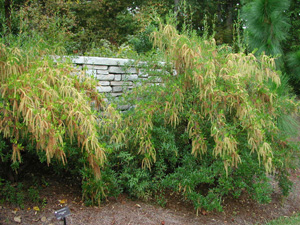Resource Library
Plant of the Week: Leatherwood
The University of Arkansas System Division of Agriculture does not promote, support or recommend plants featured in "Plant of the Week." Please consult your local Extension office for plants suitable for your region.
Plant of the Week
Leatherwood
Latin: Cyrilla racemiflora

Some of my garden colleagues consider me a lazy gardener because I don’t like to prune plants, especially shrubs. I cringe whenever I see the waste of energy expended shearing perfectly good shrubs into nondescript geometric forms.
If you really want a plant that grows in a little round ball, find one that grows that way naturally and leave the shears in the workroom. The beauty of shrubs – at least in my opinion – is allowing their natural form to be revealed over time. Plants like leatherwood (also called swamp titi or Cyrilla racemiflora) defy shearing and must be allowed to grow so that they can express themselves.
Swamp titi is a small tree or shrub of coastal swamps ranging from Virginia to Florida and west to eastern Texas. But this species is an internationalist and has pockets of distribution in Mexico, Central America and into Brazil. It is monotypic in the genus and belongs to its own plant family that has only one other genera. In tropical regions it is evergreen and can attain 30 feet in height but in more temperate regions it is mostly deciduous and grows as a 10- to 12-foot sprawling shrub.
Its glossy 3- to 4-inch-long deep green leaves are clustered near the ends of the branches. In late fall some of the leaves turn lustrous shades of red and orange that are perhaps the plant’s most outstanding characteristic. The degree of leaf retention depends on the severity of the winter with leaves mostly retained when temperatures are above 20 degrees Fahrenheit and increasingly lost as they drop below this threshold.
The tiny fragrant, five-petaled white flowers are produced in 4-inch long slender racemes in early summer. The racemes are produced at the base of new growth flushes in airy clusters that look like they are in bloom longer than they actually are because the developing seedpods – at least from a distance – have a similar appearance.
Cyrilla was named by Linnaeus in honor of Italian botanist and physician Domenico Cirillo (1739 – 1799) who wrote extensively on botanical matters in his home in Naples. During the European wars that proliferated during the close of the 18th century, Cyrilla became entangled in political matters, but during a reversal of fortune he was accused of speaking ill of the Royal family and was hanged for the offense.
Cyrilla is hardy from zones 6 through 11 where it grows in full sun or light shade. It tolerates moist soils but is at the edge of a moist spot not growing directly in water. It is usually associated with acidic sites and highly organic soils. Once established it has good drought tolerance especially considering it is native to swampy areas. It is a sprawling shrub that does not compete well with its neighbors so give it room to spread. This would be an excellent plant to add to the edge of stormwater catchment basins or rain gardens.
Shrubs like Cyrilla need some pruning to show them off to best advantage but the pruning should be thoughtful and intended to show off the plants best characteristics. Removing errant shoots with hand shears or trimming up the base to expose the attractive trunk is appropriate but mindless shearing is not.
By: Gerald Klingaman, retired
Retired Extension Horticulturist - Ornamentals
Extension News - December 7, 2012
The University of Arkansas System Division of Agriculture does not maintain lists of retail outlets where these plants can be purchased. Please check your local nursery or other retail outlets to ask about the availability of these plants for your growing area.